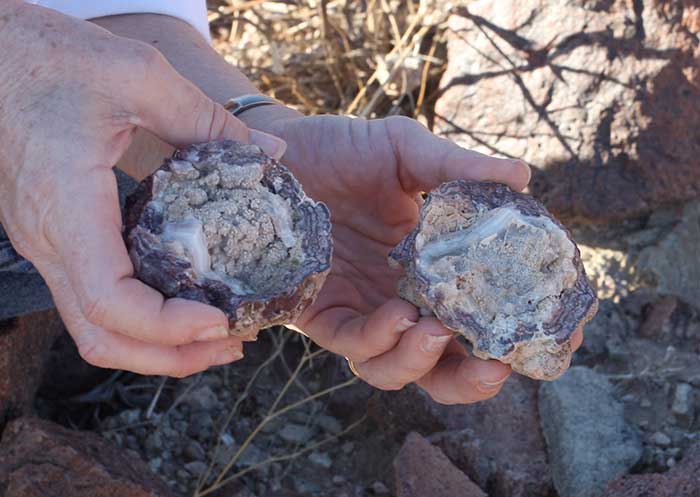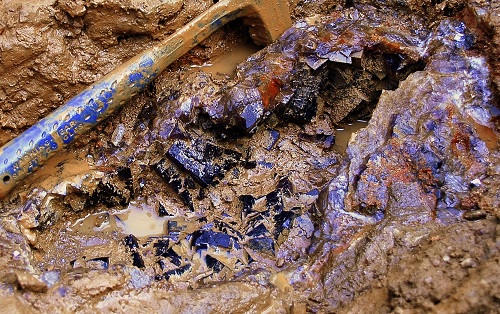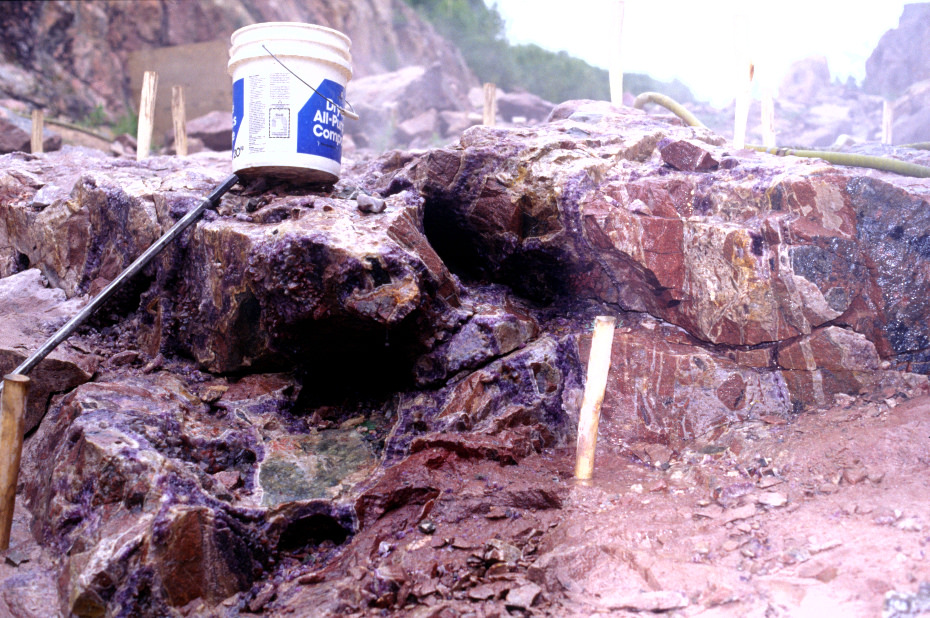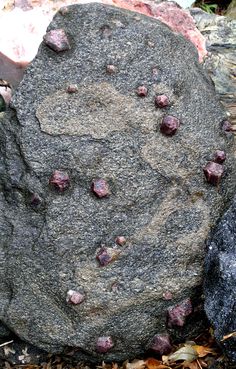This is an earthcache, there is no container to find and sign.
Instead you need to read the following text, make on site observations and answer and send your answers to the questions at the bottom to my email in order to claim this earthcache as found.
For this earthcache, you only need to walk around the courthouse here on the sidewalk. There are several points along the sidewalk that goes around the courthouse that gets you really close to the wall. DO NOT LEAVE THE SIDEWALK to touch the wall. There is no need to do that. Just make your observations and proceed to answer the questions listed below.
Geodes
Geodes are geological secondary structures which occur in certain sedimentary and volcanic rocks. They are themselves of sedimentary origin formed by chemical precipitation. Geodes are essentially hollow, vaguely spheroid to oblate masses of mineral matter that form via either of two processes:
- By the filling of vesicles (gas bubbles) in volcanic to sub-volcanic rocks by minerals deposited from hydrothermal fluids or
- By the dissolution of sedimentary nodules or concretions (that were deposited syngenetically within the rock formations in which they are found) and partial filling by the same or other minerals precipitated from diagenetic water, groundwater or hydrothermal fluids.
Geodes differ from vugs in that the former were formed as early, rounded, structures within the surrounding rock and are often removed intact, whereas vugs are irregularly shaped pockets, voids or cavities within a formation, often along a vein or in breccia. Geodes also differ from "nodules" in that a nodule is a mass of mineral matter that has accreted around the nodule nucleus. Both structures had the minerals contained within, deposited from groundwater or hydrothermal processes. Geodes commonly have a chalcedony (cryptocrystalline quartz) shell lined internally by various minerals, often as crystals, particularly calcite, pyrite, kaolinite, sphalerite, millerite, barite, celestite, dolomite, limonite, smithsonite, opal, chalcedony and macrocrystalline quartz, which is by far the most common and abundant mineral found in geodes. Geodes are found mostly in basaltic lavas and limestones. The Warsaw Formation in the Keokuk region near the area where Missouri, Iowa, and Illinois join contains abundant geodes.
Geodes can form in any cavity, but the term is usually reserved for more or less rounded formations in igneous and sedimentary rocks. They can form in gas bubbles in igneous rocks, such as vesicles in basaltic lavas; or, as in the American Midwest, in rounded cavities in sedimentary formations. After rock around the cavity hardens, dissolved silicates and/or carbonates are deposited on the inside surface. Over time, this slow feed of mineral constituents from groundwater or hydrothermal solutions allows crystals to form inside the hollow chamber. Bedrock containing geodes eventually weathers and decomposes, leaving them present at the surface if they are composed of resistant material such as quartz. Geode banding and coloration is the result of variable impurities. Iron oxides will impart rust hues to siliceous solutions. Most geodes contain clear quartz crystals, while others have purple amethyst crystals. Still others can have agate, chalcedony, or jasper banding or crystals such as calcite, dolomite, celestite, etc. Geodes from a particular area are usually similar in appearance.
Geodes come in all different sizes like the small sized one on the left and the rather large one on the right.


vugh
Vugs (also spelled vugh) are small to medium-sized cavities inside rock that may be formed through a variety of processes. Most commonly cracks and fissures opened by tectonic activity (folding and faulting) are partially filled by quartz, calcite, and other secondary minerals. Open spaces within ancient collapse breccias are another important source of vugs. Vugs may also result when mineral crystals or fossils inside a rock matrix are later removed through erosion or dissolution processes, leaving behind irregular voids. The inner surfaces of such vugs are often coated with a crystal druse. Fine crystals are often found in vugs where the open space allows the free development of external crystal form. The term vug is not applied to veins and fissures that have become completely filled, but may be applied to any small cavities within such veins. Geodes are a common vug formed rock, although that term is usually reserved for more rounded crystal-lined cavities in sedimentary rocks and ancient lavas.
Here are some examples of vugs in there natural state.


Nodule
In sedimentology and geology, a nodule is small, irregularly rounded knot, mass, or lump of a mineral or mineral aggregate that typically has a contrasting composition, such as a pyrite nodule in coal, a chert nodule in limestone, or a phosphorite nodule in marine shale, from the enclosing sediment or sedimentary rock. Normally, a nodule has a warty or knobby surface and exists as a discrete mass within the host strata. In general, they lack any internal structure except for the preserved remnants of original bedding or fossils. Nodules are closely related to concretions and sometimes these terms are used interchangeably. Minerals that typically form nodules include calcite, chert, apatite (phosphorite), anhydrite, and pyrite. In sedimentology and geology, nodular is used to describe sediment or sedimentary rock composed of scattered to loosely packed nodules in matrix of like or unlike character.
Here are some examples of Nodule's in there natural state.


**Logging requirements**
DO NOT POST ANSWERS IN YOUR LOG.
Send the following answers to me via email.
- The text "GC68TRF Cavities" on the first line
- What do some of the rocks in the courthouse walls have? Geodes, Vugs or Nodule
- What colors are present in the crystals within the rocks? Remember if they are from one particular area the colors will be roughly the same.
- Based on your observations, did these rocks all come from roughly the same area?
Photo credits:
- http://www.desertusa.com/desert-prospecting/photos/IMG_0613.jpg
- http://i.ebayimg.com/00/s/NDIwWDU5OQ==/z/XJUAAOSwFAZTrdD8/$_1.JPG?set_11.JPG?set_id=807
- http://www.jwjrocks.com
- https://c2.staticflickr.com/8/7441/12294400186_9922d22009_b.jpg
- selmantopal.com
- https://natureinfocus.files.wordpress.com